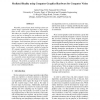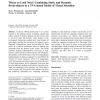50 search results - page 10 / 10 » Image Sequence Analysis of Real World Human Body Motion |
CVPR
1998
IEEE
13 years 8 months ago
1998
IEEE
Most of behavior recognition methods proposed so far share the limitations of bottom-up analysis, and singleobject assumption; the bottom-up analysis can be confused by erroneous ...
ICRA
2007
IEEE
13 years 11 months ago
2007
IEEE
— Most robotic vision algorithms are proposed by envisaging robots operating in structured environments where the world is assumed to be rigid. These algorithms fail to provide o...
ISWC
2002
IEEE
13 years 10 months ago
2002
IEEE
Wearable, camera based, head–tracking systems use spatial image registration algorithms to align images taken as the wearer gazes around their environment. This allows for compu...
FGR
2004
IEEE
13 years 9 months ago
2004
IEEE
We describe how to create with machine learning techniques a generative, videorealistic, speech animation module. A human subject is first recorded using a videocamera as he/she u...
COGCOM
2010
13 years 2 months ago
2010
To decide ``Where to look next ?'' is a central function of the attention system of humans, animals and robots. Control of attention depends on three factors, that is, lo...


